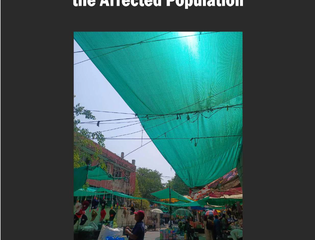Download Lessons paper
Summary
As a result of climate change, we are experiencing more frequent and more intense weather events such as droughts, flooding and tropical storms, each of which pose major humanitarian consequences in all regions of the world, including those where such events were previously rare or unknown.
ALNAP's Lessons Paper Adapting humanitarian action to the effects of climate change presents a series of lessons for humanitarian practitioners working in areas that have been or are likely to be affected by climate change in the future. It covers general lessons on humanitarian action and climate change, lessons on imperfectly understood disasters, and lessons from new weather events.
Key learning that runs throughout the lessons:
- We need become more flexible
- We need to develop collaborative partnerships
- We need more meaningful engagement with communities vulnerable to climate change
Details:
- Publication language: English
- Pages: 77pp
- Suggested citation: de Geoffroy, V., Knox Clarke, P., Bhatt, M. and Grunewald, F. (2021) Adapting humanitarian action to the effects of climate change. London: ALNAP.
Lessons in the paper listed by theme:
LESSON 18: Humanitarian actors and their partners should enhance preparedness for climate-related crises by prepositioning emergency stocks and supplies, building capacity and providing information
LESSON 21: Humanitarian agencies need to reflect on the past, learn from the present and actively imagine the near, increasingly threatening future
LESSON 22: Humanitarian actors and their partners should ensure that disaster responses to tropical storms should take account of potential secondary effects, such as flash floods, landslides and disease
LESSON 23: Humanitarian actors, their partners and affected communities should invest in new types of alarm and alert systems, giving priority to systems that transmit information and making use of all available options
LESSON 24: Humanitarian actors should listen to affected people and communities, recognise the importance of their anticipatory capacity and champion further research on how traditional knowledge can inform us about risks and potential disasters
LESSON 37: Humanitarian actors should contribute to awareness-building among groups who do not understand the dangers of extremely high temperatures or heatwaves
LESSON 25: Humanitarian actors, their partners and affected communities should invest in new information and communication technologies, from dedicated tools to user-generated data systems
LESSON 26: Local authorities, working with humanitarian actors and other partners, should develop alternative shelter and evacuation systems in regions that are not typically disaster zones, but which could be affected by tropical storms in future
LESSON 27: The likelihood of new forms of extreme climate effects and weather events caused by climate change necessitates improved dialogue and coordination between government and civil society on how to respond to and manage them
LESSON 28: Humanitarian actors and partners – especially at local level – should recognise and support immediately following a disaster any effective informal first-response networks or citizen-led responses
LESSON 29: Women are key actors in managing unknown risks and should be properly supported and empowered in preparing and responding to new dynamics of tropical storms
LESSON 35: Humanitarian actors should support and play their part in multisectoral approaches across shelter, urban planning, WASH and public health to help communities improve their capacity to withstand and respond to the effects of heatwaves
LESSON 36: Governments, researchers and humanitarian actors should share the financial burden of mitigation activities
LESSON 38: Advocate for greater investment into early warning against heatwaves
LESSON 39: Humanitarian and other donors should invest more time and resources in better risk assessment and improved monitoring and evaluation of heatwave preparedness and adaptation programmes and activities
LESSON 40: Humanitarian and other actors should design their interventions in ways that engage affected communities in heatwave mitigation plans and programmes
LESSON 1: Develop the ability to design and implement a range of programme types (resilience, disaster risk reduction, anticipation and response) to ensure an effective and joined-up response
LESSON 2: Respond to the uncertainty of the climate crisis by developing the ability to work flexibly and adaptively at individual, programmatic and organisational levels
LESSON 3: Consider the impact of climate change in regions experiencing armed conflict and find ways to work with development actors and governments to deliver climate-related programming in conflict areas
LESSON 4: Improve the ability to evaluate and learn from resilience-building activities, climate-related adaptation and anticipatory and preparedness efforts in order to focus resources on the most effective approaches
LESSON 5: Address internal silos by undertaking joint analysis, creating cross-sectoral teams and restructuring where necessary
LESSON 6: Decentralise decision-making to create programmes that fit the context and can overcome sectoral silos
LESSON 7: Partner with development and climate actors, using joint analysis and common standards
LESSON 8: Co-design climate change programmes with vulnerable people and groups, ensuring that they understand and can discuss climate change, its effects and the potential impact on their lives and livelihoods
LESSON 9: Design climate programmes with an understanding of how vulnerability occurs in that context, making sure that activities are relevant and accessible to marginalised groups in terms of resources, capacities and social networks
LESSON 10: Build on existing structures as the default approach to all climate-related activities, looking for local systems of administration and welfare systems that can take the lead where central government is weak or engaged in conflict
LESSON 11: 'Climate-proof’ existing resilience, disaster risk reduction and preparedness activities and ensure that they do not make people more vulnerable to the effects of climate change in the longer term
LESSON 12: Acknowledge the scale of the resilience challenge, being realistic about what can be achieved and clear about the limits of their respective capacities to contribute to resilience
LESSON 13: Do not conflate income with resilience; rather also consider other paths, particularly health and community empowerment
LESSON 14: Ensure that forecasting and early warning systems are reviewed after each disaster event, and routinely at fixed intervals over the longer term
LESSON 15: Designers of early warning, early action and anticipatory activities should build in flexibility
LESSON 16: Ensure that planned early actions are realistic, with implementation systems ready in place
LESSON 17: Early warning and early action systems will not be effective every time. Humanitarian actors and their partners should clarify what levels of uncertainty they are prepared to accept and plan to respond to disasters that were unanticipated or on a larger scale than expected
LESSON 18: Enhance preparedness for climate-related crises by repositioning emergency stocks and supplies, building capacity and providing information
LESSON 19: Tropical storms increasingly present new or unexpected patterns and can catch the population or responding institutions off guard; understanding the new risks entailed is central to preparing and responding
LESSON 30: Humanitarian actors and their partners should formulate programmatic responses to the challenges presented by extreme heat and heatwaves


